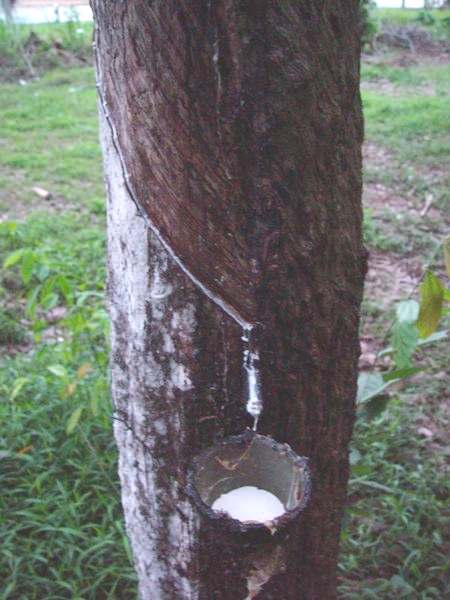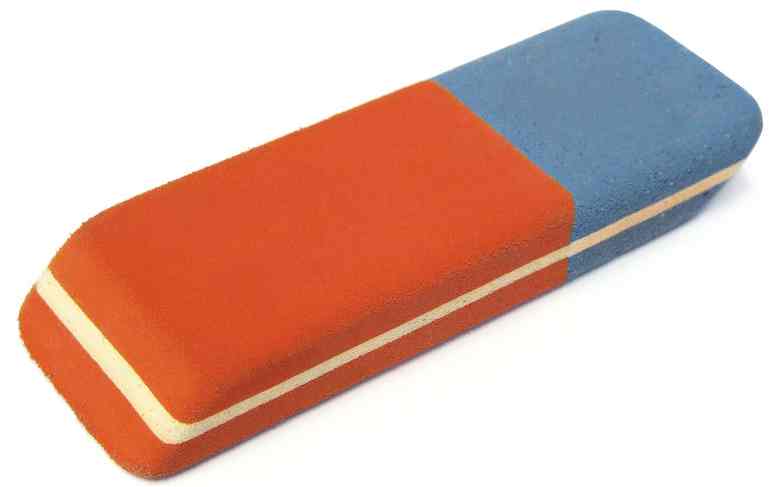|
RUBBER TREES
|
||
|
HOME | BIOLOGY | FILMS | GEOGRAPHY | HISTORY | INDEX | INVESTORS | MUSIC | SOLAR BOATS | SPORT |
||
|
Rubber is an elastic hydrocarbon polymer which occurs as a milky emulsion (known as latex) in the sap of several varieties of plants. Rubber can also be produced synthetically.
Synthetic rubber is made through the polymerisation of a variety of monomers to produce polymers. These form part of a broad study covered by Polymer science and Rubber technology.
The major commercial source of natural latex used to create rubber is the Para rubber tree, Hevea brasiliensis (Euphorbiaceae). This is largely because it responds to wounding by producing more latex. Henry Wickham gathered thousands of seeds from Brazil in 1876 and they were germinated in Kew Gardens, England. The seedlings were sent to Colombo, Indonesia, and Singapore.
Latex being collected from a tapped rubber tree
Other plants containing latex include figs, (Ficus elastica), euphorbias, and the common dandelion. Although these have not been major sources of rubber, Germany attempted to use such sources during World War II when it was cut off from rubber supplies. These attempts were later supplanted by the development of synthetic rubber. Its density is 920 kg/m3.
In places like Kerala, where coconuts are in abundance, the shell of half a coconut is used as the collection container for the latex. The shells are attached to the tree via a short sharp stick and the latex drips down into it overnight. This usually produces latex up to a level of half to three quarters of the shell. The latex from multiple trees is then poured into flat pans, and this is mixed with formic acid, which serves as a coagulant. After a few hours, the very wet sheets of rubber are wrung out by putting them through a press before they are sent onto factories where vulcanization and further processing is done.
Aside from a few natural product impurities, natural rubber is essentially a polymer of isoprene units, a hydrocarbon diene monomer. Synthetic rubber can be made as a polymer of isoprene or various other monomers. Rubber is believed to have been named by Joseph Priestley, who discovered in 1770 that dried latex rubbed out pencil marks. The material properties of natural rubber make it an elastomer and a thermoplastic.
History
In its native Central America and South America, rubber has been collected for a long time. The Mesoamerican civilizations used rubber mostly from Castilla elastica. The Ancient Mesoamericans had a ball game using rubber balls (see: Mesoamerican ballgame), and a few Pre-Columbian rubber balls have been found (always in sites that were flooded under fresh water), the earliest dating to about 1600 BC. According to Bernal Díaz del Castillo, the Spanish Conquistadores were so astounded by the vigorous bouncing of the rubber balls of the Aztecs that they wondered if the balls were enchanted by evil spirits. The Maya also made a type of temporary rubber shoe by dipping their feet into a latex mixture. Rubber was used in various other contexts, such as strips to hold stone and metal tools to wooden handles, and padding for the tool handles. While the ancient Mesoamericans did not have vulcanization, they developed organic methods of processing the rubber with similar results, mixing the raw latex with various saps and juices of other vines, particularly Ipomoea alba, a species of Morning glory. In Brazil the natives understood the use of rubber to make water-resistant cloth. A story says that the first European to return to Portugal from Brazil with samples of such water-repellent rubberized cloth so shocked people that he was brought to court on the charge of witchcraft.
A typical school rubber (British English)
When samples of rubber first arrived in England, it was observed by Joseph Priestley, in 1770, that a piece of the material was extremely good for rubbing out pencil marks on paper, hence the name.
The para rubber tree initially grew in South America, where it was the main source of what limited amount of latex rubber was consumed during much of the 19th century. About 100 years ago, the Congo Free State in Africa was a significant source of natural rubber latex, mostly gathered by forced labor. The Congo Free State was forged and ruled as a personal colony by the Belgian King Leopold II where millions of Africans died as a result of lust for rubber and rubber profits. After repeated efforts rubber was successfully cultivated in Southeast Asia, where it is now widely grown.
Properties
Rubber exhibits unique physical and chemical properties.
Rubber's stress-strain behavior exhibits the Mullins effect, the Payne effect and is often modeled as hyperelastic.
Why does rubber have elasticity?
In most elastic materials, such as metals used in springs, the elastic behaviour is caused by bond distortions. When stress is applied, bond lengths deviate from the (minimum energy) equilibirum and strain energy is stored electrostatically. Rubber is often assumed to behave in the same way, but it turns out this is a poor description. Rubber is a curious material because, unlike metals, strain energy is stored thermally, as well as electrostatically.
In its relaxed state rubber consists of long, coiled-up monomer chains that are interlinked at a few points. Between a pair of links each monomer can rotate freely about its neighbour. This gives each section of chain leeway to assume a large number of geometries, like a very loose rope attached to a pair of fixed points. At room temperature rubber stores enough kinetic energy so that each section of chain oscillates chaotically, like the above piece of rope being shaken violently.
When rubber is stretched the "loose pieces of rope" are taut and thus no longer to able to oscillate. Their kinetic energy is given off as excess heat. Therefore, the entropy decreases when going from the relaxed to the stretched state, and it increases during relaxation. This change in entropy can also be explained by the fact that a tight section of chain can fold in fewer ways (W) than a loose section of chain, at a given temperature (nb. entropy is defined as S=k*ln(W)). Relaxation of a stretched rubber band is thus driven by an increase in entropy, and the force experienced is not electrostatic, rather it is a result of the thermal energy of the material being converted to kinetic energy. Rubber relaxation is endothermic. The material undergoes adiabatic cooling during contraction. This property of rubber can easily be verified by holding a stretched rubber band to your lips and relaxing it.
Stretching of a rubber band is in some ways equivalent to the compression of an ideal gas, and relaxation in equivalent to its expansion. Note that a compressed gas also exhibits "elastic" properties, for instance inside an inflated car tire. The fact that stretching is equivalent to compression may seem somewhat counter-intuitive, but it makes sense if rubber is viewed as a one-dimensional gas. Stretching reduces the "space" available to each section of chain.
Vulcanization of rubber creates more disulphide bonds between chains so it makes each free section of chain shorter. The result is that the chains tighten more quickly for a given length of strain. This increases the elastic force constant and makes rubber harder and less extentable.
When cooled below the glass transition temperature, the quasi-fluid chain segments "freeze" into fixed geometries and the rubber abruptly loses its elastic properties, though the process is reversible. This is a property it shares with most elastomers. At very cold temperatures rubber is actually rather brittle; it will break into shards when struck. This critical temperature is the reason that winter tires use a softer version of rubber than normal tires. The failing rubber o-ring seals that contributed to the cause of the Challenger disaster were thought to have cooled below their critical temperature. The disaster happened on an unusually cold day.
Current sources of rubber
Today Asia is the main source of natural rubber. Over half of the rubber used today is synthetic, but several million tonnes of natural rubber are still produced annually, and is still essential for some industries, including automotive and military.
Hypoallergenic rubber can be made from Guayule.
Early experiments in the development of synthetic rubber led to the invention of Silly Putty.
Natural rubber is often vulcanized, a process by which the rubber is heated and sulfur, peroxide or Bisphenol are added to improve resilience and elasticity, and to prevent it from perishing. Vulcanization greatly improved the durability and utility of rubber from the 1830s on. The successful development of vulcanisation is most closely associated with Charles Goodyear. Carbon black is often used as an additive to rubber to improve its strength, especially in vehicle tires.
LINKS
A taste for adventure capitalists
Solar Cola - a healthier alternative
|
||
|

